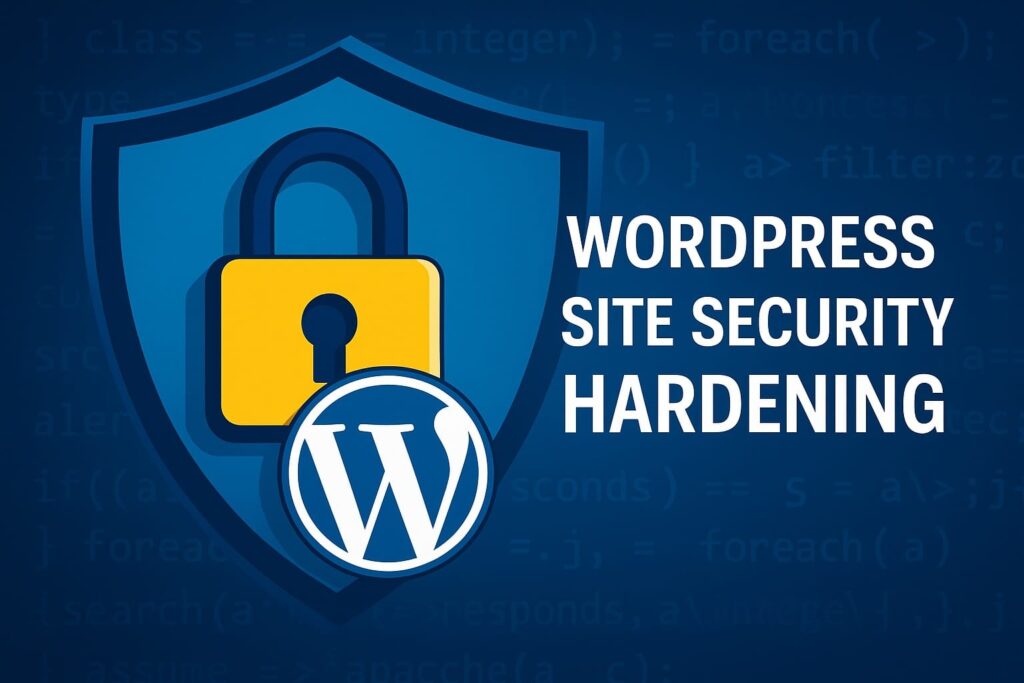Introduction
In an era where cyber-attacks are growing more sophisticated by the day, securing your WordPress website isn’t optional—it’s essential. This guide dives deep into WordPress site security hardening, equipping you with proven strategies, step-by-step configurations, and best practices to safeguard your site against hackers, malware, and data breaches in 2025.
1. Keep WordPress Core, Themes & Plugins Up to Date
Outdated software is the #1 entry point for attackers.
- Enable automatic updates for minor core releases.
- Regularly review and update themes/plugins (ideally on a staging site first).
- Remove unused or abandoned plugins.
2. Enforce Strong Authentication
Weak credentials are an open door.
- Strong Passwords: Use at least 12 characters with mixed case, numbers, and symbols.
- Two-Factor Authentication (2FA): Implement via plugins like Wordfence or Authy.
- Limit Login Attempts: Block IPs after 3–5 failed attempts.
3. Lock Down File Permissions
Correct file permissions prevent unauthorized file changes.
find /path/to/wordpress/ -type f -exec chmod 644 {} \;
find /path/to/wordpress/ -type d -exec chmod 755 {} \;
chmod 600 wp-config.php
Files: 644 (owner read/write; group/others read)
Folders: 755 (owner read/write/execute; group/others read/execute)
wp-config.php: 600 (owner read/write only)
4. Secure wp-config.php & Database
Your wp-config.php stores critical credentials.
- Move
wp-config.phpone directory above the public root if possible. - Set Database Prefix: Change default
wp_to a unique prefix (e.g.,wp3f9a_). - Disable File Editing:
define('DISALLOW_FILE_EDIT', true); define('DISALLOW_FILE_MODS', true);
5. Disable XML-RPC & REST API Endpoints You Don’t Use
Attackers often exploit XML-RPC and unused REST routes.
- Disable XML-RPC:
add_filter('xmlrpc_enabled', '__return_false'); - Restrict REST API: Use a plugin or custom code to limit access to authenticated users only.
6. Web Application Firewall (WAF) & Security Plugins
A WAF filters malicious traffic before it hits your server.
- Cloud-based WAF: Services like Cloudflare, Sucuri, or StackPath.
- WordPress Security Plugins:
- Wordfence: Endpoint firewall + malware scanner.
- iThemes Security: Brute-force protection, file change detection.
- BulletProof Security: .htaccess lock-down for Apache servers.
7. Enforce HTTPS Everywhere
SSL/TLS encrypts data in transit, preventing eavesdropping and injection attacks.
- Obtain a free SSL certificate from Let’s Encrypt (or your host).
- Force HTTPS site-wide:
RewriteEngine On RewriteCond %{HTTPS} !=on RewriteRule ^ https://%{HTTP_HOST}%{REQUEST_URI} [L,R=301] - Update hard-coded HTTP links via a search-and-replace tool or plugin.
8. Regular Backups & Disaster Recovery
Backups are your safety net.
- Frequency: Daily for active sites; weekly for low-traffic blogs.
- Storage: Keep off-site copies (e.g., Amazon S3, Google Drive).
- Plugins: UpdraftPlus, BackupBuddy, or Jetpack Backup.
9. Malware Scanning & Monitoring
Stay ahead of infections.
- Automated Scans: Schedule scans with your security plugin.
- File Integrity Monitoring: Alert on unexpected changes in core files.
- Log Monitoring: Use a service like Sucuri or WP Activity Log to track logins, content changes, and plugin installations.
10. Harden Your Server & Database
Lock down at the infrastructure level:
- SSH Keys Only: Disable password login over SSH.
- Database User Privileges: Grant only necessary rights (avoid GRANT ALL).
- Disable Directory Indexing:
Options -Indexes
Conclusion & Next Steps
By following these 10 core hardening strategies, you’ll dramatically reduce your site’s attack surface and bolster defenses against today’s cyber threats. Remember: security is an ongoing process—schedule quarterly reviews of your settings and stay informed about new vulnerabilities.
